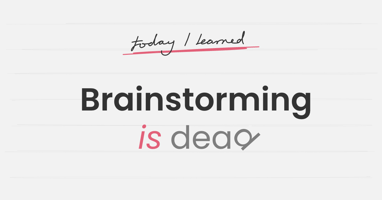Genius is not a commodity and luck is not something you can rely on.
Imagine the series of events that led to the moment that the apple struck Newton on the head, and how different the outcome might have been had he reacted differently.
You could almost equate this with the equivalent of a modern-day ideation moment:
Step 1: Locate genius.
Step 2: Place genius under an apple at precise moment that stem detaches from the apple, causing apple to fall and strike genius on head.
Possible outcomes:
1. Ouch … Move away from tree. Result - No pain or discovery. Problem solved.
2. Ouch … Pick up apple and eat. Result - Immediate gratification. Problem solved.
3. Ouch … Apply additional analysis. Result - three laws of motion. Many problems solved, many opportunities created.
For those who need a reminder here are Newton's three laws of motion:
1. Every object in a state of uniform motion tends to remain in that state of motion unless an external force is applied to it.
2. The relationship between an object's mass m, its acceleration a, and the applied force F is F = ma. Acceleration and force are vectors (as indicated by their symbols being displayed in slant bold font); in this law the direction of the force vector is the same as the direction of the acceleration vector.
3. For every action there is an equal and opposite reaction.
What we know for sure is that when it comes to ideas, not every company employs geniuses or implements formal idea generation and development. In most cases, exploration and decision-making around ideas likely doesn't get the requisite analysis, resulting in outcomes with negative or limited success or, even worse, no impact at all. Capturing and prioritizing ideas, products and projects, aligning and optimizing them, requires applied intelligence to solve real problems and create real innovations. Luck is a poor strategy.
It has taken over 300 years of additive experience, applied intelligence and analysis to exploit what Newton first conceptualized, but it all began with an idea. Most people understand that modern business decision-making can benefit from applied analysis. To do this, however, the problem or strategy must first be widely shared and understood, and a common process of analysis must be applied. This is a not something that most companies do well. Research shows that:
- 82% of companies can't tell whether their portfolio is aligned with strategic targets.
- 85% of companies make investment decisions based on politics rather than data.
- 74% of innovation ideas do not support business strategies.
Things change. Markets, competitive pressures, and financial positions are just a few examples. A good idea today may not be one tomorrow, and its impact and associated risk should both be understood and managed. It's often that someone is aware of the changes in the market or one of the other variables impacting an idea, project, or product, but she does not understand the impact of the change due to a lack of applied analysis. So my advice is this: don't depend on the rarity of genius and expose the future success of your company to the vagaries of luck.
An innovation process, managed through a common platform, allows companies to align product development, portfolios, and innovation work with corporate strategy, and provide much needed visibility to ensure efficient prioritization of ideas, projects and resources. It's all about solving problems, reducing risk and creating opportunities for innovation through applied intelligence.
Recommended reading:





